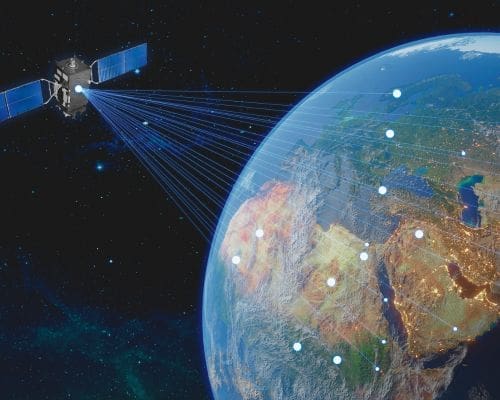OneWeb launch LEO Maritime Service
Last month global satellite communication provider OneWeb, announced the launch of their LEO satellite service for the maritime sector. Based on LEO (low-earth orbit) satellite technology, the service is designed to enhance connectivity and communication capabilities for maritime users. The launch, which was announced at the Nor Shipping event in Oslo, will signal the commencement of their ‘try before you buy service’. This is a trial period of 45 days available to maritime customers.
Who are OneWeb?
OneWeb are a UK-based satellite communications provider founded in 2012, of which the UK Government are a significant investor. A rival to Starlink, the company aims to provide high-speed, affordable internet access globally, with a focus on remote, currently underserviced areas.
In 2014 the company announced plans to deploy a constellation of 648 satellites in low earth orbit (LEO). The large volume ensures consistent, global coverage and accounts for redundancy. Despite a number of setbacks, including financial difficulties and delayed satellite launches, as of 2023, OneWeb has 634 operational satellites in low Earth orbit, providing service down to 35 degrees latitude.
OneWeb Maritime
Due to the growing demand for connectivity at sea (a recent Inmarsat study found that data usage within the industry increased by a further 131% from June 2021 to June 2022), and the limitations of the current service offerings in the sector, OneWeb provides an exciting solution. As with Starlink, due to its large LEO constellation, it can provide low latency, greater coverage and higher bandwidth than Geo-based alternatives. In an era of increasing connectivity, reliable and efficient communication is integral on a superyacht for various purposes such as safety and operational efficiency, crew welfare and navigation. Improved connectivity also delivers a greater guest experience, enabling users to enjoy two-way data applications such as gaming and streaming 4k HD video.
When all satellites and ground stations are fully operational, the service will provide global coverage, ensuring a reliable connection for maritime users, particularly beneficial for vessels operating in remote areas.
In terms of hardware, OneWeb have teamed up with US-based Kymeta, and South-Korean company Intellian to provide the services antennas. Designed for the harsh conditions of the oceans, these antennas will operate in extreme temperatures, with optional heating mechanisms that allow UTs to perform down to -40 degree C.



What is the difference between OneWeb and Starlink?
For those familiar with SpaceX’s Starlink, you may be thinking that this new offering from OneWeb sounds very similar, however there are a few key differentiators.
Root to market – B2B
Unlike Starlink who are selling direct to households and customers, OneWeb are operating as a B2B service. OneWeb will be partnering with existing telecommunication and IT providers, such as OceanWeb, to distribute the service to end customers, such as superyachts. OneWeb’s CEO Neil Masterson said of this approach “One of the reasons we’re going down that sort of B2B route is because we think that those players already working in those markets and communities … understand the price points of the end consumers really well.”
Service Level Agreements
A standout difference is OneWeb’s approach to delivering a quality service. As with VSAT (the current standard for offshore connectivity), OneWeb is based on a Service Level Agreement (SLA) model. This means customers can select packages based on their Committed Information Rate (CIR) or Maximum Information Rate (MIR) requirements. A contract with a clear CIR is key benefit to vessels, as it means that they are guaranteed a certain level of service, unlike Starlink which works on a ‘best efforts’ basis.
Furthermore, OneWeb are providing a 24/7 Customer Technical Assistance Centre (CTAC), connecting partners to inhouse specialists for any assistance and troubleshooting required.
Higher orbit
OneWebs satellites sit at 1,200km above the earth’s surface, this is at a higher orbit than Starlinks mega constellation at 550km. Based on this altitude, OneWeb are marketing speeds greater than 200Mbps with a latency lower than 100 milliseconds. Whilst these statistics are highly impressive, it is still in theory a lower performing solution that Starlinks claims of latencies between 25 to 50 milliseconds. However, what delivers best in practise, at scale, remains to be seen.
It is important to note that this is only the beginning for OneWeb, with ambitious plans for phase 2 and beyond. As demand continues to grow for connectivity, so will the number of players entering the mega constellation market. Amazon’s Project Kupier, Facebook Athena and O3b mPower are all projects with exciting potential for the maritime sector.
To learn more about OneWeb and their maritime superyacht connectivity offering please contact our sales team at sales@oceanweb.com.
Recent Comments